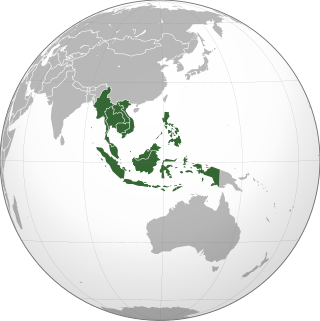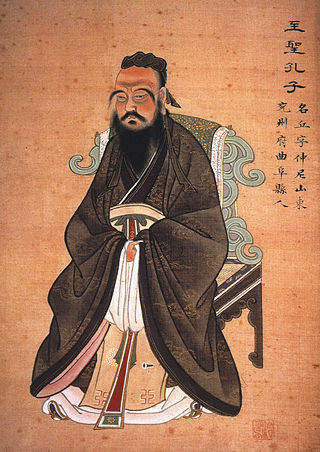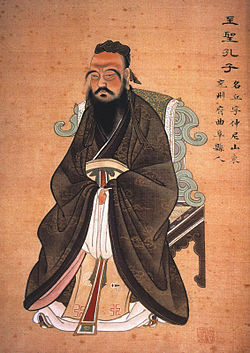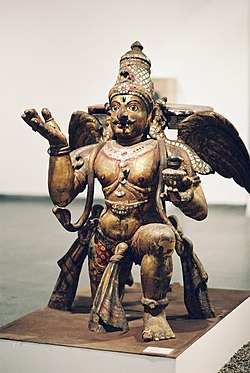Eastern culture
Norms, values, customs and political systems of the Eastern world From Wikipedia, the free encyclopedia
Eastern culture, also known as Eastern civilization and historically as Oriental culture, is an umbrella term for the diverse cultural heritages of social norms, ethical values, traditional customs, belief systems, political systems, artifacts and technologies of the Eastern world.
This article has multiple issues. Please help improve it or discuss these issues on the talk page. (Learn how and when to remove these messages)
|
Confucius's teachings and philosophy has influenced many Eastern cultures, known as Confucianism.
Gautama Buddha, the founder of Buddhism. Born in modern-day Nepal, his teachings are venerated by numerous religions and communities in countries within East, Southeast and South Asia.
The Garuda, a Hindu demigod and divine creature mentioned in the Hindu, Buddhist and Jain faiths. It is a part of the state insignia of India, Indonesia and Thailand. The Indonesian official coat of arms is centered on the Garuda, and as the symbol of Ulaanbaatar, Mongolia.
While there is no singular and catch-all "Eastern culture", there are subgroups within it, such as countries within East Asia, Southeast Asia, or South Asia, as well as syncretism within these regions. These include the spread of Eastern religions such as Buddhism or Hinduism, the usage of Chinese characters or Brahmic scripts, language families, the fusion of cuisines, and traditions, among others.
Terminology
Summarize
Perspective
An image of the "Eastern world" defined as the "Far East", consisting of three overlapping cultural blocks: East Asia (Green), Southeast Asia (Blue), and South Asia (Orange)
A map highlighting the "easts" as defined by Near East/Middle East (West Asia excluding the South Caucasus, with countries in "Greater Middle East" sometimes included) and Far East (East, North and Southeast Asia, with South Asia sometimes also included).
Buddhist expansion in Asia: Mahayana Buddhism first entered the Chinese Empire (Han dynasty) through Silk Road during the Kushan Era. The overland and maritime "Silk Roads" were interlinked and complementary, forming what scholars have called the "great circle of Buddhism".
The East, as a geographical area, is unclear and undefined. More often, the ideology of a state's inhabitants is what will be used to categorize it as an Eastern society. There is some disagreement about what nations should or should not be included in the category and at what times. Many parts of the Eastern Roman (Byzantine) Empire are considered to be distinct from the West and therefore labelled as eastern by most scholars. The Byzantine Empire was primarily influenced by Eastern practices due to its proximity and cultural similarity to Iran and Arabia, thus lacking features seen as "Western". Both Eastern and Western European authors have often perceived Byzantium as a body of religious, political, and philosophical ideas contrary to those of the West.
It is difficult to determine which individuals fit into which category, and the East–West contrast is sometimes criticized as relativistic and arbitrary.[1][2][3] Globalism has spread Western ideas so widely that almost all modern cultures are, to some extent, influenced by aspects of Eastern culture. Stereotypical views of "the East" have been labeled Orientalism, paralleling Occidentalism—the term for the 19th-century stereotyped views of "the West".
As Europeans discovered the wider world, old concepts adapted. The area that had formerly been considered the Orient ("the East") became the Near East as the interests of the European powers interfered with Meiji Japan and Qing China for the first time in the 19th century.[4] Thus, the Sino-Japanese War in 1894–1895 occurred in the Far East while the troubles surrounding the decline of the Ottoman Empire simultaneously occurred in the Near East.[a] The term Middle East in the mid-19th century included the territory east of the Ottoman Empire, but West of China—Greater India and Greater Persia—is now used synonymously with "Near East" in most languages.
Traditions
Summarize
Perspective







While there is no singular Eastern culture of the Eastern world, there are subgroups within it, such as countries within East Asia, Southeast Asia, or South Asia, as well as syncretism within these regions. These include the spread of Eastern religions such as Buddhism or Hinduism, the usage of Chinese characters or Brahmic scripts, language families, the fusion of cuisines, and traditions, among others. Eastern culture has developed many themes and traditions. Some important ones are listed below:
Religion
- Eastern religions (see also Eastern philosophy)
- Taoic religions (a.k.a. East Asian religions)
- Chinese folk religion – a general term covering a range of traditional religious practices of Han Chinese, including the Chinese diaspora.
- Confucianism – a system of thought and behavior originating in ancient China that developed from what was later called the Hundred Schools of Thought from the teachings of the Chinese philosopher Confucius.
- Taoism – an ancient Chinese school of philosophical thought and religion that emphasizes living in harmony with the Tao. The Tao Te Ching, a book containing teachings attributed to Laozi, together with the later writings of Zhuangzi, are both widely considered the keystone works of Taoism.
- Shinto – an ancient religion that originated in Japan. Its practitioners often regard it as Japan's indigenous religion and as a nature religion.
- Korean shamanism – an animistic ethnic religion of Korea dating back to prehistory and consists of the worship of gods and ancestors as well as nature spirits.
- Manchu shamanism – an animistic and polytheistic religion practiced by most of the Manchu people, believing in several gods and spirits, led by a universal sky god who is the source of all life and creation.
- Tengrism – an ancient ethnic and state Turko-Mongolic religion originating in the Eurasian steppes, based on folk shamanism, animism and generally centered around the titular sky god Tengri.
- Mongolian shamanism – the animistic and shamanic ethnic religion that has been practiced in Mongolia and its surrounding areas (including Buryatia and Inner Mongolia) at least since the age of recorded history.
- Shamanism in Siberia – religio-cultural practices of shamanism followed by a large minority of people in Siberia, and regarded by some researchers as the heartland of shamanism.
- Dharmic religions (a.k.a. Indian religions)
- Hinduism – an ancient faith that evolved from the Vedic religion of North India.
- Buddhism – an ancient religion and philosophical tradition based on a series of original teachings attributed to Gautama Buddha.
- Jainism – an ancient religion that traces its spiritual ideas and history through the succession of twenty-four Tirthankaras (supreme preachers of Dharma), the last of whom was Mahāvīra.
- Sikhism – a relatively new religion that developed in the warring plains of 15th-century Punjab in an atmosphere of ideological war between Islam and Hinduism. Its followers retain spiritual as well as martial qualities.
- Taoic religions (a.k.a. East Asian religions)
- Zoroastrianism – the ancient monotheistic state religion of Sassanid Iran.
- Abrahamic religions (see also religion in the Middle East)
- Christianity – the majority of the modern world adheres to this faith, although it is no longer widely practiced in its native continent of Asia. Since the faith spread to Europe in antiquity, the notion of "Europe" and the "Western world" has been intimately connected with the concept of "Christianity and the Christian world". Many even attribute Christianity for being the link that created a unified European identity.[5] In Asia, Cyprus, Georgia, Armenia, Russia, the Philippines and East Timor are the only Christian-majority countries,[6] though there are also minority Christian populations in the Levant, Anatolia, Fars, and Kerala that have preserved their ancient beliefs, adhering to Syriac Christianity (i.e. Assyrian and Maronite people), an Eastern Christian sect.[7] Significant Christian communities are also found in Central Asia, mainland China, Hong Kong, India, Indonesia, Japan, Macau, Malaysia, South Korea, Singapore, Taiwan and Vietnam.[6]
- Islam – the majority of the world's Muslim population has always lived in Asia, due to Islam spreading and becoming the dominant religion of West Asia, Central Asia and Southeast Asia.
- Judaism – the ancient religion of the Israelites or Hebrews of the Fertile Crescent,[8] who lived in what is now Israel, Palestine, Jordan, Syria, and Lebanon. They eventually evolved into the Ashkenazi, Sephardic, and Mizrahi Jews and Samaritans of today.
- Druze faith – an esoteric ethnoreligious group that resides primarily in Syria, Lebanon, Israel and Jordan.[9]
Cinema
- East Asian cinema
- Southeast Asian cinema
- South Asian cinema
- Afghan cinema
- Bangladeshi cinema
- Bhutanese cinema
- Indian cinema
- Assamese cinema
- Bengali cinema
- Bhojpuri cinema
- Chhattisgarhi cinema
- Deccani cinema
- Dogri cinema
- Gujarati cinema
- Haryanvi cinema
- Hindi cinema
- Kannada cinema
- Kashmiri cinema
- Konkani cinema
- Malayalam cinema
- Meitei cinema
- Marathi cinema
- Oriya cinema
- Punjabi cinema
- Rajasthani cinema
- Sanskrit cinema
- Tamil cinema
- Telugu cinema
- Tulu cinema
- Pakistani cinema
- Nepali cinema
- Sri Lankan cinema
- Central Asian cinema
- West Asian cinema
- Arab cinema
- Armenian cinema
- Azerbaijani cinema
- Bahraini cinema
- Cypriot cinema
- Egyptian cinema
- Emirati cinema
- Georgian cinema
- Iranian cinema
- Iraqi cinema
- Israeli cinema
- Jordanian cinema
- Kuwaiti cinema
- Lebanese cinema
- Omani cinema
- Palestinian cinema
- Qatari cinema
- Saudi Arabian cinema
- Syrian cinema
- Turkish cinema
- Yemeni cinema
- North Asian cinema
Cuisine
- East Asian cuisine
- Chinese cuisine
- Anhui cuisine
- Beijing cuisine
- Cantonese cuisine
- Chinese aristocrat cuisine
- Chinese imperial cuisine
- Chinese Islamic cuisine
- Hakka cuisine
- Henan cuisine
- Hubei cuisine
- Hunan cuisine
- Guizhou cuisine
- Jiangsu cuisine
- Jiangxi cuisine
- Northeastern Chinese cuisine
- Shaanxi cuisine
- Shandong cuisine
- Shanghai cuisine
- Shanxi cuisine
- Sichuan cuisine
- Teochew cuisine
- Tianjin cuisine
- Tibetan cuisine
- Uyghur cuisine
- Yunnan cuisine
- Zhejiang cuisine
- Hong Kong cuisine
- Japanese cuisine
- Korean cuisine
- Macanese cuisine
- Mongolian cuisine
- Taiwanese cuisine
- Chinese cuisine
- Southeast Asian cuisine
- South Asian cuisine
- Afghan cuisine
- Balochi cuisine
- Bangladeshi cuisine
- Bengali cuisine
- Bhutanese cuisine
- Cuisine of the Indian subcontinent
- Hazara cuisine
- Indian cuisine
- Anglo-Indian cuisine
- Arunachalese cuisine
- Assamese cuisine
- Bihari cuisine
- Bhojpuri cuisine
- Buddhist cuisine
- Goan cuisine
- Gujarati cuisine
- Indian Chinese cuisine
- Indian fast food
- Jharkhandi cuisine
- Maharashtrian cuisine
- Malvani cuisine
- Manipuri cuisine
- Meghalayan cuisine
- Mizo cuisine
- Naga cuisine
- North Indian cuisine
- Cuisine of Odisha
- Sikkimese cuisine
- South Indian cuisine
- Tripuri cuisine
- Maithil cuisine
- Maldivian cuisine
- Mughlai cuisine
- Nepalese cuisine
- Pakistani cuisine
- Parsi cuisine
- Pashtun cuisine
- Punjabi cuisine
- Sri Lankan cuisine
- Tamil cuisine
- Central Asian cuisine
- West Asian cuisine
- Arab cuisine
- Armenian cuisine
- Assyrian cuisine
- Azerbaijani cuisine
- Bahraini cuisine
- Cypriot cuisine
- Eastern Arabian cuisine
- Egyptian cuisine
- Emirati cuisine
- Georgian cuisine
- Iranian cuisine
- Iraqi cuisine
- Israeli cuisine
- Jordanian cuisine
- Kurdish cuisine
- Kuwaiti cuisine
- Lebanese cuisine
- Levantine cuisine
- Mizrahi Jewish cuisine
- Omani cuisine
- Ossetian cuisine
- Palestinian cuisine
- Qatari cuisine
- Saudi Arabian cuisine
- Syrian cuisine
- Turkish cuisine
- Yemeni cuisine
- North Asian cuisine
Cultures
- East Asian culture
- Southeast Asian culture
- South Asian culture
- Central Asian culture
- West Asian culture
- Arab culture
- Culture of Abkhazia
- Culture of Armenia
- Culture of Artsakh
- Assyrian culture
- Culture of Azerbaijan
- Culture of Bahrain
- Culture of Eastern Arabia
- Culture of Egypt
- Culture of Georgia
- Culture of Iraq
- Culture of Iran
- Culture of Israel
- Culture of Jordan
- Culture of Kuwait
- Culture of Lebanon
- Culture of Northern Cyprus
- Culture of Palestine
- Culture of Qatar
- Culture of Saudi Arabia
- Culture of Syria
- Culture of Turkey
- Culture of the United Arab Emirates
- Culture of Yemen
- North Asian culture
Medicine
Gallery
- Zhájiàng Miàn (noodles with bean paste) is a traditional northern Chinese dish.
- Mooncakes with Chinese characters 金門旦黃 (jinmen danhuang).
- Sushi from Japan has become prevalent even among Westerners.
- A cup of Japanese matcha tea.
- Bulgogi, Korean-style marinated sliced meat.
- Japchae, a kind of Korean noodle dish made with marinated beef and vegetables in soy sauce and sesame oil.
- Mongolian Buuz.
- Kaeng kanun, a northern Thai curry made with jackfruit.
- Tapsilog, a common breakfast meal in the Philippines.
- Butter chicken and butter naan from India.
- Mix vegetables curry with garlic kulcha in India.
- Kebabs are a popular cuisine among Middle Easterners.
- Armenian khash (or pacha), which is also commonly eaten by Assyrians, Arabs and Kurds.
- Round challah, a special bread in Jewish cuisine
- Minangkabau Tari Lilin (candle dance)
- Ramoji Film City located in Hyderabad, holds the Guinness World Record for the World's largest film studio.[10]
- The Tian Tan Buddha statue in Hong Kong.
- A Syro-Malabar Catholic bishop holding the Mar Thoma Christian Cross which symbolizes the heritage and identity of the Syrian Church of Saint Thomas Christians of India
- Assyrian Christians from lake Urmia in north western Persia in their traditional costumes.
- The Monastery of St. Matthew, located atop Mount Alfaf in northern Iraq, is recognized as one of the oldest Christian monasteries in existence.
- Aerial view of Masada, Israel
See also
Notes
- British archaeologist D. G. Hogarth published The Nearer East in 1902, which helped to define the term and its extent, including Albania, Montenegro, southern Serbia and Bulgaria, Greece, Egypt, all Ottoman lands, the entire Arabian Peninsula, and Western parts of Iran.
References
Bibliography
Wikiwand - on
Seamless Wikipedia browsing. On steroids.







































